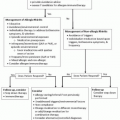I. CLINICAL MANIFESTATIONS
A. Normal reactions to insect bites and stings generally cause localized itching, pain, burning, redness, and mild swelling. This normal reaction is caused by several components in the saliva (bites) or venom (stings) of the insects, including enzymatically active proteins and vasoactive amines (e.g., histamine and kinins). The reaction usually subsides in hours, although some individuals with sensitive skin describe more intense local reactions lasting several days.
B. Large local reactions are usually late-phase allergic reactions causing severe swelling contiguous with the site of the sting; swelling distant from the site of the sting would be a sign of systemic reaction with angioedema. The abnormal swelling often begins more than 6 hours after the sting, enlarging for 24 to 48 hours and resolving slowly over an additional 2 to 7 days. Such large local reactions cause induration and tense edema larger than 8 cm in diameter and can involve an entire limb. The intense local inflammation may cause the appearance of lymphangitic streaks toward the inguinal or axillary nodes, but this should not be mistaken for cellulitis when it appears in the first 24 to 48 hours. Infection at the site of the sting is quite uncommon and takes more than 48 hours to develop. Large local reactions are not usually dangerous, but in the head and neck area, they could cause delayed localized compression of the airway, especially in the case of a sting on the tongue or pharynx.
C. Systemic reactions may cause any one or more of the signs and symptoms of anaphylaxis. Cutaneous signs occur in more than 80% of all cases and are the only manifestation of the reaction in 15% of adults. Airway symptoms (throat tightness, dyspnea, cough, wheezing) are reported by 50% to 60% of adults and children, and circulatory
symptoms (dizziness, syncope, hypotension, unconsciousness) occur in 30% of adults. Children have a higher frequency of isolated cutaneous reactions (60% of cases) and a lower frequency of vascular symptoms and anaphylactic shock (5%) compared to adults. Systemic reactions can become progressively more severe with each sting in some cases but usually follow a more predictable and individual pattern in each patient. Anaphylaxis can be protracted or biphasic in more than 20% of cases of severe (grade 3 or 4) systemic reactions, so medical observation is recommended for 6 hours. Occasionally, individuals are resistant to epinephrine, especially those taking a beta-blocker medication. Patients discharged from emergency care of anaphylaxis must receive instructions on the need for an epinephrine autoinjector device, an allergy consultation, and preventative treatment. It should be explained to all patients that self-administered epinephrine is not a substitute for emergency medical attention.
D. Toxic reactions have occurred after multiple stings, and very large numbers (in the hundreds) can be fatal (e.g., Africanized honeybees). Other unusual patterns of reactions have been reported including nephropathy, central and peripheral neurologic syndromes, idiopathic thrombocytopenic purpura, and rhabdomyolysis, but these responses are not immunoglobulin E (IgE) mediated. Serum sickness reactions to stings are infrequent but have been related to venom-specific IgE antibodies. There are also reports of allergic sting reactions being followed by months of chronic urticaria or cold urticaria.
II. INSECT ANTIGENS
The most common insects causing systemic allergic reactions are of the order Hymenoptera (
Table 14-1). There are three Hymenoptera families of importance: Bees (honeybees, bumblebees) and vespids (yellow jackets, hornets, wasps) are best known. Fire ants (
Solenopsis sp.) have become a rapidly increasing public health hazard in the southeast and south central United States, particularly on the Gulf Coast.
For 50 years, whole-body extracts were used for skin testing and immunotherapy, because it was believed that allergic sensitivity was related to an “intrinsic bee protein” present in the whole insect body as well as the venom. In the 1970s it was established that whole-body extract tests and treatment were no more effective than placebo (except for fire ants), whereas immunotherapy utilizing purified venom effectively prevented anaphylaxis in 80% to 98% of patients (depending on the species). Honeybee venom is immunochemically distinct, and the primary allergen is phospholipase A. Africanized honeybees (“killer bees”) do not differ from other honeybees in the quantity or quality of the venom, but they have a great tendency to swarm and attack, thus causing life-threatening or fatal toxic reactions when they sting in the hundreds. The vespid venoms have a high degree of cross-reactivity, and the same primary allergen, “antigen 5,” is present in yellow jacket and hornet venoms.
Polistes wasps are more distantly related to the other vespids, and only 50% of yellow jacket-allergic patients have positive tests to wasp venom related to the cross-reactivity of the major allergen. Fire ant venoms are quite different in that
they contain very little protein in an unusual suspension of alkaloid toxins that cause the characteristic painful vesicular eruption. The allergenic proteins in fire ant venoms are unique, except for one that shows limited cross-reactivity with vespid allergens. The diagnostic and therapeutic materials currently supplied by commercial laboratories are fire ant whole-body extracts, but unlike the situation with the other Hymenoptera, these fire ant extracts show reasonable allergenic activity for diagnostic skin testing and for preventive immunotherapy (but with no placebo-controlled studies).
III. EPIDEMIOLOGY AND NATURAL HISTORY OF REACTIONS
A. Large local reactions occur with uncertain frequency but are estimated to affect 10% of adults, possibly because the size of the reaction is subject to exaggeration. Most patients (60% to 80%) with large local reactions have positive venom skin tests, but the natural history of large local reactions in children and adults suggests a 4% to 10% frequency of systemic reactions to subsequent stings.
B. Systemic reactions to insect stings can develop at any age, often following a number of uneventful stings. Systemic allergic reactions have been reported to occur in approximately 3% of adults and 1% of children. At least 50 fatal sting reactions occur each year in the United States, and many other sting fatalities are believed to go unrecognized. In cases of unexplained sudden death in the summer, postmortem blood samples often show the presence of venom-specific IgE antibodies as well as an elevated level of serum tryptase, strongly suggesting the possibility of fatal insect sting anaphylaxis.
The risk of anaphylaxis to a subsequent sting varies according to the history and skin tests. The highest risk (60% to 70%) is in patients who have had recent and severe reactions. The chance of another systemic reaction never disappears but declines slightly over time. Some studies suggest that the risk is as low as 25% after 10 years, while other studies find no correlation between the chance of sting reaction and the time since the last reaction. The risk of anaphylaxis can persist for decades even with no intervening stings. The lowest risk is in children with isolated cutaneous systemic reactions (generalized urticaria and/or cutaneous angioedema), who have <15% risk of urticaria and <3% risk of anaphylaxis to subsequent stings.
C. IgE antibodies to Hymenoptera venoms are frequently found in the adult population. More than 20% of normal adults have positive skin tests or serologic tests for IgE antibodies to yellow jacket or honeybee venom, and these patients invariably report prior stings but very few report abnormal reactions to those stings. Half of those with positive tests became negative after a few years, but more than 15% of those who were later stung had a systemic reaction. In untreated patients with systemic reactions to stings, venom skin tests may gradually become weaker over time but do not usually become negative during 5 to 10 years of follow-up. In patients receiving venom immunotherapy (VIT), venom-specific IgE increases in the first few months of initial therapy, returns to baseline after 1 year, and then declines steadily with time (even after an intercurrent sting or after venom therapy is discontinued). After 6 and 10 years of VIT, these patients become skin test negative in approximately 25% and 67% of cases, respectively.
D. Children have an estimated prevalence of systemic reactions to stings of at least 0.4% to 0.8%. The notion that children routinely outgrow insect sting allergy is probably due to the large number of children with isolated urticaria after a sting. In children with strictly cutaneous systemic reactions, the risk of anaphylaxis after a subsequent sting is <3%. However, children with histories of moderate or severe reactions who did not receive VIT experienced systemic reactions in 25% to 40% of cases when they were stung up to 20 years later. Children who received VIT had a much lower risk of developing systemic reactions even 10 or more years after stopping treatment.







